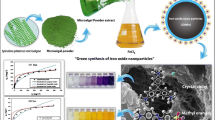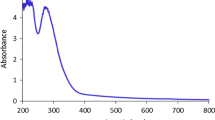Abstract
In comparison to algal biomass, algae-based nanoparticle (green synthesis) not only aids in the removal of toxins from wastewater, but it is also an ecologically benign strategy with enhanced efficacy. In the present study, Spirulina is being utilised to make green iron oxide nanoparticles (S-IONPs), which further used to make an effective adsorbent for the removal of cationic crystal violet (CV) dye using ultra-sonic waves. The created nano-adsorbent was thoroughly investigated using a variety of characterisation techniques, including FT-IR, XRD, FE-SEM, and UV–VIS spectroscopy. Moreover, the S-IONPs adsorbent performed remarkably well in removing key chemicals from synthetic solutions, such as dyes. The pseudo-second order model was used to describe the kinetic profile, while the linearized Langmuir theory with r2 of 0.96413 and qmax of 55.62 mg/g was used to show the adsorption isotherm. Sequestration of the CV dye from aqueous solution using S-IONPs was carried out efficiently. The potential of S-IONPs for decolorization of crystal violet dye solution was also confirmed through various analytical techniques.
Graphical Abstract
Preparation of Spirulina based iron oxide nanoparticles for sequestration of Crystal Violet dye from aqueous solution












Similar content being viewed by others
References
Mansingh S, Sultana S, Acharya R, Ghosh MK, Parida KM (2020) Efficient photon conversion via double charge dynamics CeO2–BiFeO3 p–n hetero junction photocatalyst promising toward N2 fixation and phenol–Cr (VI) detoxification. Inorg Chem 59(6):3856–3873
Zhang J, Zheng J, Yang W (2020) Co-degradation of ammonia nitrogen and 4-chlorophenol in a photoelectrochemical system by a tandem reaction of chlorine and hydroxyl radicals. Chem Eng Sci 226:115813
Liu YC, Li J, Ahn J, Pu J, Rupa EJ, Huo Y, Yang DC (2020) Biosynthesis of zinc oxide nanoparticles by one-pot green synthesis using fruit extract of Amomum longiligulare and its activity as a photocatalyst. Optik 218:165245
Schweitzer L, Noblet J (2018) Water contamination and pollution. In: Green chemistry. Elsevier, New York, pp 261–290
Sellaoui L, Dhaouadi F, Li Z, Cadaval TR Jr, Igansi AV, Pinto LA, Chen Z (2021) Implementation of a multilayer statistical physics model to interpret the adsorption of food dyes on a chitosan film. J Environ Chem Eng 9(4):105516
Sekine K, Roskosky M (2018) Emergency response in water, sanitation and hygiene to control cholera in post-earthquake Nepal in 2016. J Water Sanit Hygiene Dev 8(4):799–802
Das P, Ghosh S, Ghosh R, Dam S, Baskey M (2018) Madhuca longifolia plant mediated green synthesis of cupric oxide nanoparticles: a promising environmentally sustainable material for waste water treatment and efficient antibacterial agent. J Photochem Photobiol B 189:66–73
Lü XF, Ma HR, Zhang Q, Du K (2013) Degradation of methyl orange by UV, O 3 and UV/O 3 systems: analysis of the degradation effects and mineralization mechanism. Res Chem Intermed 39(9):4189–4203
Katheresan V, Kansedo J, Lau SY (2018) Efficiency of various recent wastewater dye removal methods: a review. J Environ Chem Eng 6(4):4676–4697
Islam MA, Ali I, Karim SA, Firoz MSH, Chowdhury AN, Morton DW, Angove MJ (2019) Removal of dye from polluted water using novel nano manganese oxide-based materials. J Water Process Eng 32:100911
Abbasi A, Ghanbari D, Salavati-Niasari M, Hamadanian M (2016) Photo-degradation of methylene blue: photocatalyst and magnetic investigation of Fe2O3–TiO2 nanoparticles and nanocomposites. J Mater Sci 27(5):4800–4809
Senthilkumaar S, Kalaamani P, Subburaam CV (2006) Liquid phase adsorption of crystal violet onto activated carbons derived from male flowers of coconut tree. J Hazard Mater 136(3):800–808
Au W, Pathak S, Collie CJ, Hsu TC (1978) Cytogenetic toxicity of gentian violet and crystal violet on mammalian cells in vitro. Mutat Res 58(2–3):269–276
Li Z, Sellaoui L, Gueddida S, Dotto GL, Lamine AB, Bonilla-Petriciolet A, Badawi M (2020) Adsorption of methylene blue on silica nanoparticles: modelling analysis of the adsorption mechanism via a double layer model. J Mol Liq 319:114348
Mahmoodi NM, Hayati B, Arami M, Mazaheri F (2010) Single and binary system dye removal from colored textile wastewater by a dendrimer as a polymeric nanoarchitecture: equilibrium and kinetics. J Chem Eng Data 55(11):4660–4668
Shaul GM, Holdsworth TJ, Dempsey CR, Dostal KA (1991) Fate of water soluble azo dyes in the activated sludge process. Chemosphere 22(1–2):107–119
Aksu Z, Tezer S (2005) Biosorption of reactive dyes on the green alga Chlorella vulgaris. Process Biochem 40(3–4):1347–1361
Doğar Ç, Gürses A, Açıkyıldız M, Özkan E (2010) Thermodynamics and kinetic studies of biosorption of a basic dye from aqueous solution using green algae Ulothrix sp. Colloids Surf B 76(1):279–285
Chowdhury S, Chakraborty S, Saha P (2011) Biosorption of Basic Green 4 from aqueous solution by Ananas comosus (pineapple) leaf powder. Colloids Surf B 84(2):520–527
Barka N, Abdennouri M, Makhfouk ME (2011) Removal of Methylene Blue and Eriochrome Black T from aqueous solutions by biosorption on Scolymus hispanicus L.: kinetics, equilibrium and thermodynamics. J Taiwan Inst Chem Eng 42(2):320–326
Şeker A, Shahwan T, Eroğlu AE, Yılmaz S, Demirel Z, Dalay MC (2008) Equilibrium, thermodynamic and kinetic studies for the biosorption of aqueous lead (II), cadmium (II) and nickel (II) ions on Spirulina platensis. J Hazard Mater 154(1–3):973–980
Çelekli A, Bozkurt H (2011) Bio-sorption of cadmium and nickel ions using Spirulina platensis: kinetic and equilibrium studies. Desalination 275(1–3):141–147
Fang L, Zhou C, Cai P, Chen W, Rong X, Dai K, Huang Q (2011) Binding characteristics of copper and cadmium by cyanobacterium Spirulina platensis. J Hazard Mater 190(1–3):810–815
Rahim A, Çakir C, Ozturk M et al (2021) Chemical characterization and nutritional value of Spirulina platensis cultivated in natural conditions of Chichaoua region (Morocco). South Afr J Bot.
Darezereshki E, Ranjbar M, Bakhtiari F (2010) One-step synthesis of maghemite (γ-Fe2O3) nano-particles by wet chemical method. J Alloys Compd 502(1):257–260
Lewis Oscar F, MubarakAli D, Nithya C, Priyanka R, Gopinath V, Alharbi NS, Thajuddin N (2015) One pot synthesis and anti-biofilm potential of copper nanoparticles (CuNPs) against clinical strains of Pseudomonas aeruginosa. Biofouling 31(4):379–391
Chari N, Felix L, Davoodbasha M, Ali AS, Nooruddin T (2017) In vitro and in vivo antibiofilm effect of copper nanoparticles against aquaculture pathogens. Biocatal Agric Biotechnol 10:336–341
Shafreen RB, Seema S, Ahamed AP, Thajuddin N, Alharbi SA (2017) Inhibitory effect of biosynthesized silver nanoparticles from extract of Nitzschia palea against curli-mediated biofilm of Escherichia coli. Appl Biochem Biotechnol 183(4):1351–1361
Demirezen DA, Yıldız YŞ, Yılmaz Ş, Yılmaz DD (2019) Green synthesis and characterization of iron oxide nanoparticles using Ficus carica (common fig) dried fruit extract. J Biosci Bioeng 127(2):241–245
Paiva-Santos AC, Herdade AM, Guerra C, Peixoto D, Pereira-Silva M, Zeinali M, Veiga F (2021) Plant-mediated green synthesis of metal-based nanoparticles for dermopharmaceutical and cosmetic applications. Int J Pharm 597:120311
Shalaby SM, Madkour FF, El-Kassas HY, Mohamed AA, Elgarahy AM (2021) Green synthesis of recyclable iron oxide nanoparticles using Spirulina platensis microalgae for adsorptive removal of cationic and anionic dyes. Environ Sci Pollut Res 28(46):65549–65572
Khan F, Shahid A, Zhu H, Wang N, Javed MR, Ahmad N, et al (2022) Prospects of algae-based green synthesis of nanoparticles for environmental applications. Chemosphere 133571.
Ho YS (2004) Selection of optimum sorption isotherm. Carbon 42(10):2115–2116
Ho YS, McKay G (1999) Pseudo-second order model for sorption processes. Process Biochem 34(5):451–465
Chaudhary S, Kaur Y, Umar A, Chaudhary GR (2016) Ionic liquid and surfactant functionalized ZnO nanoadsorbent for recyclable proficient adsorption of toxic dyes from waste water. J Mol Liq 224:1294–1304
Bishnoi S, Kumar A, Selvaraj R (2018) Facile synthesis of magnetic iron oxide nanoparticles using inedible Cynometra ramiflora fruit extract waste and their photocatalytic degradation of methylene blue dye. Mater Res Bull 97:121–127
Rahmani R, Gharanfoli M, Gholamin M, Darroudi M, Chamani J, Sadri K, Hashemzadeh A (2020) Plant-mediated synthesis of superparamagnetic iron oxide nanoparticles (SPIONs) using aloe vera and flaxseed extracts and evaluation of their cellular toxicities. Ceram Int 46(3):3051–3058
Elgarahy AM, Elwakeel KZ, Elshoubaky GA, Mohammad SH (2019) Microwave-accelerated sorption of cationic dyes onto green marine algal biomass. Environ Sci Pollut Res 26(22):22704–22722
Madubuonu N, Aisida SO, Ali A, Ahmad I, Zhao TK, Botha S, Ezema FI (2019) Biosynthesis of iron oxide nanoparticles via a composite of Psidium guavaja-Moringa oleifera and their antibacterial and photocatalytic study. J Photochem Photobiol B 199:111601
Kouhbanani M, Beheshtkhoo N, Taghizadeh S, Amani A, Alimardani V (2019) One-step green synthesis and characterization of iron oxide nanoparticles using aqueous leaf extract of Teucrium polium and their catalytic application in dye degradation. Adv Nat Sci 10:015007. https://doi.org/10.1088/2043-6254/aafe74
Lakshmnarayanan S, Shereen MF, Niraimathi KL, Brindha P, Arumugam A (2021) One-pot green synthesis of iron oxide nanoparticles from Bauhinia tomentosa: characterization and application towards synthesis of 1, 3 diolein. Sci Rep 11(1):1–13
Jagathesan G, Rajiv P (2018) Biosynthesis and characterization of iron oxide nanoparticles using Eichhornia crassipes leaf extract and assessing their antibacterial activity. Biocatal Agric Biotechnol 13:90–94
Pai S, Kini SM, Narasimhan MK, Pugazhendhi A, Selvaraj R (2021) Structural characterization and adsorptive ability of green synthesized Fe3O4 nanoparticles to remove Acid blue 113 dye. Surf Interfaces 23:100947
Demirezen DA, Yıldız YŞ, Yılmaz DD (2019) Amoxicillin degradation using green synthesized iron oxide nanoparticles: kinetics and mechanism analysis. Environ Nanotechnol Monit Manag 11:100219
Rigueto CVT, Piccin JS, Dettmer A et al (2020) Water hyacinth (Eichhornia crassipes) roots, an amazon natural waste, as an alternative biosorbent to uptake a reactive textile dye from aqueous solutions. Ecol Eng 150:105817
Mittal H, Al Alili A, Morajkar PP, Alhassan SM (2021) Graphene oxide crosslinked hydrogel nanocomposites of xanthan gum for the adsorption of crystal violet dye. J Mol Liq 323:115034
Marrakchi F, Hameed BH, Hummadi EH (2020) Mesoporous biohybrid epichlorohydrin crosslinked chitosan/carbon–clay adsorbent for effective cationic and anionic dyes adsorption. Int J Biol Macromol 163:1079–1086
Barizão A, Silva M, Andrade M, Brito F, Gomes R, Bergamasco R (2019) Green synthesis of iron oxide nanoparticles for tartrazine and bordeaux red dye removal. J Environ Chem Eng 8:103618. https://doi.org/10.1016/j.jece.2019.103618
Rawat S, Samreen K, Nayak AK, Singh J, Koduru JR (2021) Fabrication of iron nanoparticles using Parthenium: a combinatorial eco-innovative approach to eradicate crystal violet dye and phosphate from the aqueous environment. Environ Nanotechnol Monit Manag 15:100426
Prajapati AK, Mondal MK (2021) Novel green strategy for CuO–ZnO–C nanocomposites fabrication using marigold (Tagetes spp.) flower petals extract with and without CTAB treatment for adsorption of Cr(VI) and Congo red dye. J Environ Manag 290:112615
Jabli M, Almalki SG, Agougui H (2020) An insight into methylene blue adsorption characteristics onto functionalized alginate bio-polymer gel beads with λ-carrageenan-calcium phosphate, carboxymethyl cellulose, and celite 545. Int J Biol Macromol 156:1091–1103
Pugazhendhi A, Boovaragamoorthy GM, Ranganathan K, Naushad M, Kaliannan T (2018) New insight into effective biosorption of lead from aqueous solution using Ralstonia solanacearum: characterization and mechanism studies. J Clean Prod 174:1234–1239
Rajumon R, Anand JC, Ealias AM, Desai DS, George G, Saravanakumar MP (2019) Adsorption of textile dyes with ultrasonic assistance using green reduced graphene oxide: an in-depth investigation on sonochemical factors. J Environ Chem Eng 7(6):103479
Mona S, Kaushik A, Kaushik CP (2011) Biosorption of reactive dye by waste biomass of Nostoc linckia. Ecol Eng 37:1589–1594
Mona S, Kaushik A, Kaushik CP (2011) Waste biomass of Nostoc linckia as adsorbent of crystal violet dye: optimization based on statistical model. Int Biodeterior Biodegrad 65(3):513–521
Ahmad S, Kothari R, Shankarayan R, Tyagi VV (2020) Temperature dependent morphological changes on algal growth and cell surface with dairy industry wastewater: an experimental investigation. Biotech 10(1):1–12
Acknowledgements
We acknowledge the Department of Science & Technology (DST), GoI, New Delhi for providing funding to purchase of Table Top X-ray Diffractometer under the FIST scheme in the Department of Physics, GJUS&T, Hisar and the Central Instrumentation Laboratory, GJUS&T, Hisar.
Author information
Authors and Affiliations
Corresponding author
Ethics declarations
Conflict of interest
The authors declare that they have no known competing financial interests or personal relationships that could have appeared to influence the work reported in this paper.
Additional information
Publisher's Note
Springer Nature remains neutral with regard to jurisdictional claims in published maps and institutional affiliations.
Rights and permissions
About this article
Cite this article
Bhukal, S., Sharma, A., Rishi et al. Spirulina Based Iron Oxide Nanoparticles for Adsorptive Removal of Crystal Violet Dye. Top Catal 65, 1675–1685 (2022). https://doi.org/10.1007/s11244-022-01640-3
Accepted:
Published:
Issue Date:
DOI: https://doi.org/10.1007/s11244-022-01640-3




